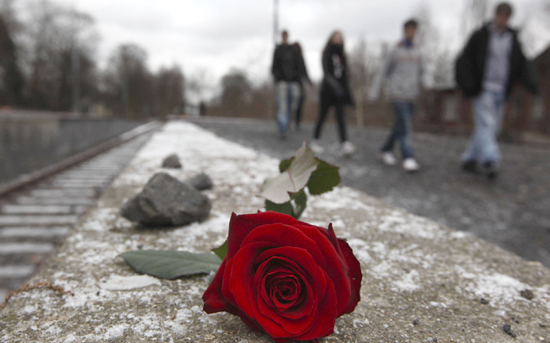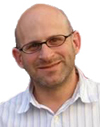Holocaust Remembrance Day: Understanding the Genocide and Commemorating the Victims
Q&A with UAlbany Associate Professor of History & Interim Director, Center for Jewish Studies Barry Trachtenberg
 |
|
The Holocaust took the lives of more than 6 million people during World War II. |
It is estimated that more than 6 million people lost their lives in the Holocaust: Nazi Germany's programmed mass murder campaign and attempted eradication of European Jewry during World War II. Established by Congress, the 'Days of Remembrance' serves as the United States' annual commemoration of the victims of the Holocaust.
This year, Holocaust Remembrance Day falls on Monday, May 2. University at Albany Associate Professor of History and Interim Director of the Center for Jewish Studies Barry Trachtenberg offers insight into the Holocaust.
Q: How has the world changed following the Holocaust?
A: One consequence of the Nazi Holocaust was to raise the world's awareness of the issue of genocide. In fact, the term "genocide" was coined by a Polish Jewish lawyer named Raphael Lemkin (1900-59), who lost 49 of his relatives during the Holocaust. Lemkin became interested in the question of mass murder prior to World War II on account of his studies of the genocidal assault on Armenians by the Ottoman Empire in 1915 and the mass murder of Assyrians in Iraq in 1933. On account of his efforts, the crime of genocide was declared in 1948 by the United Nations.
 |
|
UAlbany Associate Professor of History Barry Trachtenberg |
However, awareness of mass murder hasn't necessarily lead countries to take steps to protect civilian life. It may be that more cases of genocide have occurred in the six and a half decades following the end of the Nazi Holocaust than in the six and a half that preceded it. A main difference between the genocides that occur post-Holocaust and those prior to it is that we often learn about the killings as they are underway.
Q. The 20th century saw the birth of the airplane, television, the computer, and numerous achievements as the world entered the modern age. What conditions in Germany allowed for the Holocaust take place?
A: In his 2001 book, Modernity and the Holocaust, Polish Jewish sociologist Zygmunt Bauman demonstrates that despite our belief that technological advances inevitably lead to the advancement and improvement of humankind, the same forces can be harnessed to destroy human lives.
One of the ways that the Holocaust occurred was by using the very same industrial systems used in mid-20th century manufacturing. As World War II went on, the killing process became increasingly mechanized and more efficient. First, Nazis used open-air shootings to exterminate their victims. When that proved to be too inefficient, they "progressed" to the use of gas vans (which had to be invented, manufactured, and then refined). Eventually, they created extermination camps that were essentially factories designed to destroy rather than to create.
One thing that we learn from the study of the Holocaust is that although we imagine that technological innovations are usually made with the intention of improving our lives, they are in fact entirely neutral, as are the systems that allow them to occur.
As Hannah Arendt showed in her discussion of the 1961 trial of the Nazi official Adolf Eichmann, what was truly evil about the Holocaust was not that it was carried out by hordes of psychotic mass murderers, but that destruction on such a wide scale required managers, accountants, desk clerks, and the like, who could have just as easily put their skills to improving lives rather than destroying them.
Q. When did the rest of the world find out about the Holocaust and what was the reaction?
A: This question has been debated by scholars for decades and will continue to be contentious for a long time. It is important to understand that what we now understand as "the Holocaust" -- by which I mean the deliberate attempt to eradicate all Jews and other groups marked by the Nazi regime for total elimination -- is something that was not understood on a wide-spread basis during the war itself. Indeed, the use of the term "Holocaust" to refer to this period did not become common until the late 1970s.
During the war, it was clear to many people that Jews were being singled out, and even exterminated on a mass level, but given that the notion of genocide did not even yet exist, it was very difficult for most to comprehend the Nazi plan in its totality. Add to this: it was the war that was at the forefront of most people's minds; there was a general reluctance by Allied countries to accept refugees given the economic crises of the 1930s; there existed a rising anti-Semitism and xenophobia throughout the West; and most governments were unwilling to the risk the lives of their citizens to protect people elsewhere. Given these factors, one should perhaps not be so surprised, however disheartening, at the lack of attention to the victims of Nazi persecution.
![]() For more news, subscribe to UAlbany's RSS headline feeds
For more news, subscribe to UAlbany's RSS headline feeds
Educationally and culturally, the University at Albany-SUNY puts "The World Within Reach" for its 17,500 students. An internationally recognized research university with 50 undergraduate majors and 125 graduate degree programs, UAlbany is a leader among all New York State colleges and universities in such diverse fields as public policy, nanotechnology and criminal justice. With a curriculum enhanced by 300 study-abroad opportunities, UAlbany launches great careers. For more information about this globally ranked University, visit https://www.albany.edu/. For UAlbany's extensive roster of faculty experts, visit www.albany.edu/news/experts.shtml.




